DIGITAL NOISE (whine) Becoming more common as guitarists use more digital devices
SOUNDS LIKE many high pitched tones at once, a subtle screech
 Guitar Noise Manual by PedalSnake®
Guitar Noise Manual by PedalSnake®
.
 Jody Page, PedalSnake’s inventor and lifelong pro guitarist, is an electrical engineer (a member of NASA’s Space Foundation Hall of Fame, no less) with special training in electrical noise. In the Guitar Noise Manual, Jody starts by breaking down guitar rig noise into 6 types:
Jody Page, PedalSnake’s inventor and lifelong pro guitarist, is an electrical engineer (a member of NASA’s Space Foundation Hall of Fame, no less) with special training in electrical noise. In the Guitar Noise Manual, Jody starts by breaking down guitar rig noise into 6 types:
1) BUZZ 2) HUM 3) HISS 4) DIGITAL NOISE (WHINE) 5) POWER SUPPLY NOISE 6) CABLE MICROPHONICS
For each noise, Jody explains its causes, then offers a targeted set of solutions. Also included are several helpful articles on general best-practices for noise reduction.
.
Dealing with DIGITAL NOISE (WHINE)
Contents
So What’s the Deal With DIGITAL NOISE (WHINE)?
Current Spikes
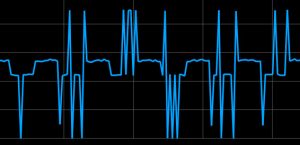 Digital circuits have clocks that step through their programs. With each clock tick, 1000’s of tiny digital bits switch on and off…very fast. This causes some pretty sharp current spikes.
Digital circuits have clocks that step through their programs. With each clock tick, 1000’s of tiny digital bits switch on and off…very fast. This causes some pretty sharp current spikes.
These spikes cause what we call “digital noise”.
It is usually a subtle yet lethal mix of various high pitched tones, combining into a piercing little whine. Just enough to annoy us.
Good Filtering
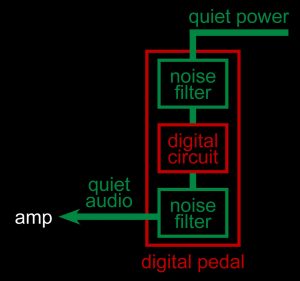 But digital pedals aren’t noisy, are they?
But digital pedals aren’t noisy, are they?
No. In fact, certain clean effects like chorus, reverb, etc., are generally quieter than their analog cousins.
This is because most pedal makers are careful to filter the digital noise out of the audio line. Otherwise, this digital whine would always be there.
The smart pedal makers (probably 90%) filter the digital noise out of their power lines as well.
Why?
Because it allows their pedals to be used on a power chain with other analog pedals, that’s why.
 .
.
We tip our hats to these fine, player-friendly pedal makers.
Bad Filtering
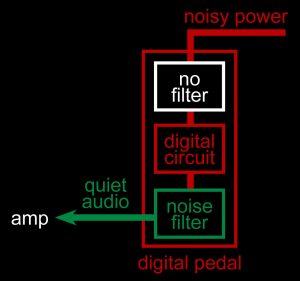 But some pedal makers don’t filter digital noise out of their power lines. Maybe they didn’t think about it, maybe they don’t know how, maybe it just costs less.
But some pedal makers don’t filter digital noise out of their power lines. Maybe they didn’t think about it, maybe they don’t know how, maybe it just costs less.
Or maybe they figure we all have expensive power supplies with all the outputs isolated from each other, so the any digital noise they let escape has nowhere to go.
Corrupting Our Chains
Chaining power to several pedals from one power supply is done by millions of players around the world. It is the most cost-effective way to power pedals quietly.
But poorly designed digital pedals are mucking this up, unfairly giving power chains a bad name. 99% of the digital noise we hear comes from the noise escaping into a power chain and infecting analog pedals that have no digital noise filters.
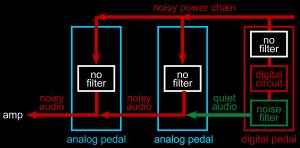
This is probably the most popular reason that expensive power supplies get sold. The good ones have all outputs isolated from one another. But this is an expensive and cumbersome solution to a simple problem.
To promote the sale of expensive power supplies, sales info tells us our power chains are the problem. We are told they cause “ground loops”, “differences in potential”, etc., and the only way to fix digital noise and have quiet power is to spend big, and isolate every pedal.
Wrong.
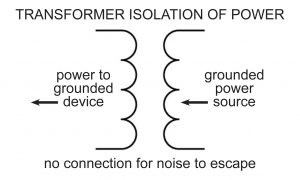 .
.
These aren’t “ground loops”, “differences in potential”, etc. This is just negligent pedal design.
And you only have to isolate the bad one(s).
.
Thankfully, not that many are bad…
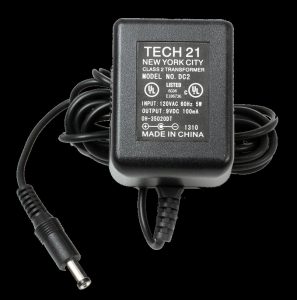 Smart Isolation: $20
Smart Isolation: $20
So, if you encounter digital noise from a pesky pedal, instead of rushing out and flushing $175 on an expensive board-mounted power supply, just purchase a 2nd isolated wall wart for $20 or less.
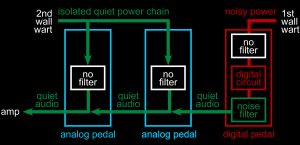 All you need to do is isolate the garbage escaping into the power line of the poorly filtered pedal. And a wall wart is quiet…just as quiet as the expensive supply. In fact, as quiet as a battery. We tested this.
All you need to do is isolate the garbage escaping into the power line of the poorly filtered pedal. And a wall wart is quiet…just as quiet as the expensive supply. In fact, as quiet as a battery. We tested this.
 Problem solved. Now you can go out and get something cool with the money you just saved.
Problem solved. Now you can go out and get something cool with the money you just saved.
(You’re welcome.)

I just came across your blog and am absolutely loving your clear, no-nonsense articles. Most of them are answering questions that have irked me for decades so I thank you enormously.
I was hoping that maybe in the ‘microphonic cables’ article it might touch upon microphonic pedals too but I couldn’t see anything. Is a microphonic pedal exactly the same problem as a cable or is something else happening? I have two pedals that are very sensitive to microphonic handling noise. One is just a cheap (is that the clue?) A/B channel switcher. If I sit it on top of an amp that is ‘ON’ I can hear it sending the signal to the amp that is ‘OFF’. Still what’s wrong with a little extra reverb? The other pedal is a cheap (hmm, THAT again) Caline Pure Sky Timmy clone which again picks up the slightest sound microphonically.
Not all cheap things do this. I also have a cheap Caline Pegasus Klon clone that has no hint of it. If I’d bought the Pure Sky first I’d have been warned off Caline pedals but I bought them in the opposite order! Any idea what the cause of a microphonic pedal is? Just the same as a cable? Is there any easy fix?
Most anything electronic can be microphonic in the right circumstances, esp tubes. But if a pedal displays microphonic handling noise, we think it mostly likely to have something to do with hi gain and the cables. But, we admit, our expertise is mainly cabling, and noise sources. We have less experience with microphonic electronics. Another person may be better to answer those types of Qs.